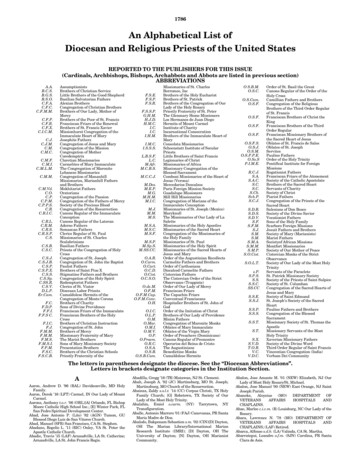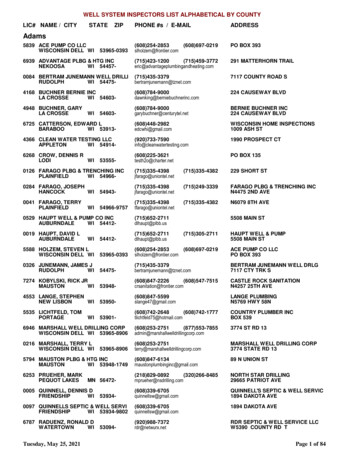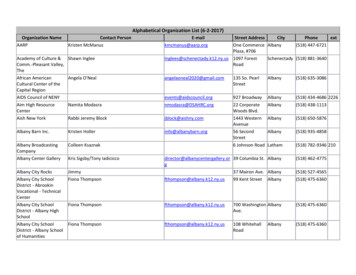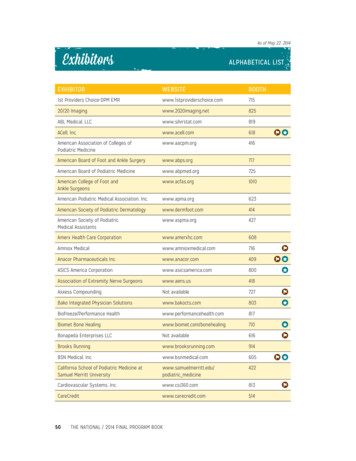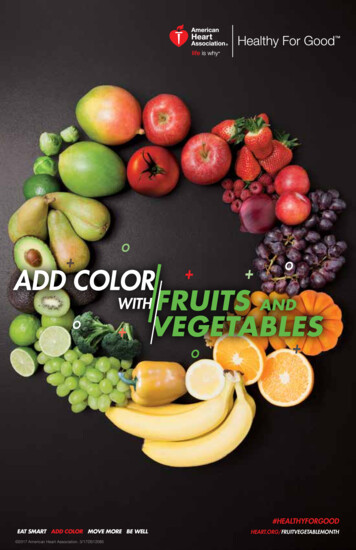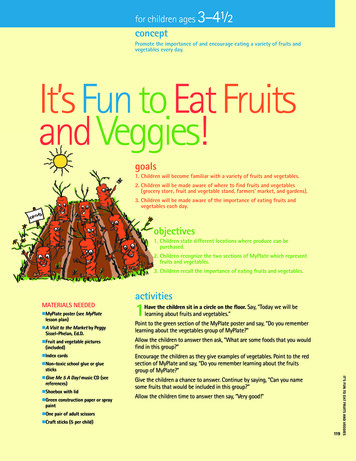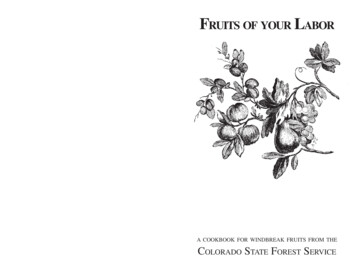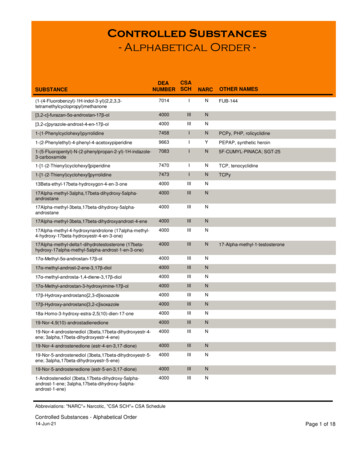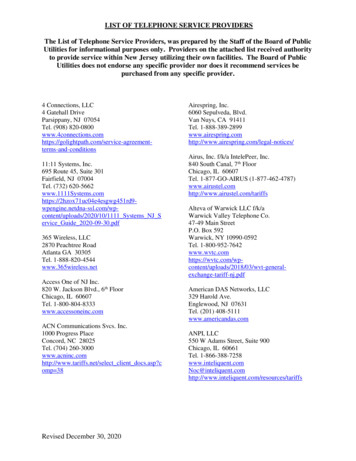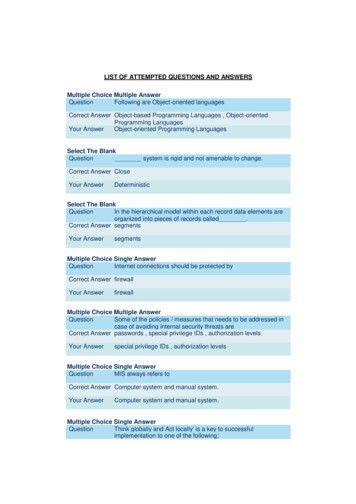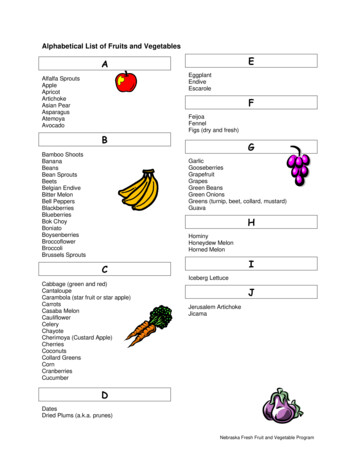
Transcription
Alphabetical List of Fruits and VegetablesEAEggplantEndiveEscaroleAlfalfa SproutsAppleApricotArtichokeAsian PearAsparagusAtemoyaAvocadoFBBamboo ShootsBananaBeansBean SproutsBeetsBelgian EndiveBitter MelonBell PeppersBlackberriesBlueberriesBok ls SproutsFeijoaFennelFigs (dry and fresh)GGarlicGooseberriesGrapefruitGrapesGreen BeansGreen OnionsGreens (turnip, beet, collard, mustard)GuavaHHominyHoneydew MelonHorned MelonICIceberg LettuceCabbage (green and red)CantaloupeCarambola (star fruit or star apple)CarrotsCasaba MelonCauliflowerCeleryChayoteCherimoya (Custard Apple)CherriesCoconutsCollard GreensCornCranberriesCucumberJJerusalem ArtichokeJicamaDDatesDried Plums (a.k.a. prunes)Nebraska Fresh Fruit and Vegetable Program
ettuce (Boston, Iceberg, Leaf, Romaine)Lima in aisinsRaspberriesRed CabbageRhubarbRomaine LettuceRutabagaSShallotsSnow PeasSpinachSproutsSquash (acorn, banana, buttercup, butternut,summer)StrawberriesString BeansSweet PotatoNNapa (Chinese toTurnipOkraOnion (green, red, Spanish, yellow, white)OrangesPPapayasParsnipPassion FruitPeachesPearsPeas (green, snow, sugar snap)Peppers (bell – red, yellow, green, PotatoesPrickly Pear (Cactus Pear)PrunesPummelo (Chinese Grapefruit)PumpkinU & VUgli FruitWWatermelonWater ChestnutsWatercressWaxed BeansX & YYamsYellow SquashYuca/CassavaZZucchini Squash
Interesting Facts About Fruits and VegetablesVegetablesSweet Gold, Green, or Red Bell PeppersThe color of the pepper depends on the variety. Peppers have a mildly sweet, slightly spicy flavor.Sweet bell peppers are available year round. Most are grown in Florida and California. In some parts ofthe United States, people call these vegetables “Mangoes,” confusing them with the sweet fruit grownmostly in Central America. Sweet bell peppers are excellent sources of vitamin C and also providevitamin A and potassium.BroccoliBroccoli is an excellent source of vitamin C and a good source of vitamin A. It is a cruciferous vegetable,part of the cabbage family. Eating cruciferous vegetables may reduce the risk of colon cancer. Broccolicontains very little sodium and fat and no cholesterol. Look for broccoli with firm, compact clusters ofsmall flower buds. The clusters should be dark green and may have a purple cast to them. Broccoli iscrisp and crunchy and is very tasty cut up and served raw with a low-fat vegetable dip.BroccoflowerIt looks like cauliflower dyed neon green. Broccoflower is a cross between cauliflower and broccoli.Introduced in Holland, it is now grown in Salinas, California. Broccoflower taste much like cauliflowerwhen it’s raw, but sweeter and less pungent. When cooked, the results taste more like broccoli.Broccoflower has more vitamin C than oranges. It’s also high in folic acid that is important to themaintenance of red blood cells that carry oxygen throughout the body. Broccoflower is also higher invitamin A than either broccoli or cauliflower.Baby CarrotsBaby carrots are produced year round. Most baby carrots are grown in California. Because of their tinysize, they are very tender, sweet, and fun to eat all by themselves as a snack. Baby carrots provide a lotof vitamin A. They are also good sources of fiber and potassium. No, baby carrots are not full sizedcarrots picked when they were babies! Producers have changed the seeds to make carrots stay tiny.TurnipsTurnips are available year round. Among the states involved in production are California, Colorado,Indiana, New Jersey, Ohio, Oregon, Texas, and Washington. Some common varieties include PurpleTop, White Glove, White Egg, Golden Ball, Amber, and Yellow Aberdeen. Turnips are a good source ofvitamin C and potassium. They can be eaten either raw or cooked, and have a crunchy delicate flavor.SpinachFresh leaf spinach is available throughout the year. Known as a food source since 647 A.D., the Chinesecalled spinach the “herb of Persia.” It was grown in America during the colonial period, probably travelingover on ships from England. The most nutritious way to serve spinach is raw in a salad, by itself, or withother mixed greens. Cooked spinach is often served as a side dish. Spinach is a rich source of iron,vitamin A, and vitamin C. Popeye knew to include this nutrient rich vegetable in his diet every day!JicamaJicama, yam bean, Mexican potato, or Mexican turnip has been eaten in Central American for manycenturies and is now common in U.S. stores. To eat Jicama, only the fibrous brownish peel must beremoved. Jicama is often added raw to salads or prepared as strips, like carrots. In Mexico the ivorycolored flesh is marinated with Mexico lime and then served topped with chili powder. A 3½ oz serving ofJicama provides 39 calories and about 25% of the RDA for vitamin C.Nebraska Fresh Fruit and Vegetable Program
CeleryCalifornia provides most of the U.S. supply of celery year round. There are two distinct types classified bycolor: green or golden. Pascal celery is the green type most people see in the grocery store. This typeof celery lacks stringiness and is known for its distinct flavor. Most people enjoy raw celery because of itscrunchiness. It is also tasty filled with peanut butter, cream cheese, or cheese spread. Celery is a mainingredient in oriental stir-fry dishes and gives flavor to soups and stews. Celery is a good source of fiber,folic acid, potassium, and vitamin C. It is a very low-calorie snack.FruitsRed Bartlett PearsBartlett pears are known as the “summer pear.” They are plentiful in June and July. Pears are one of thefew fruits that do not mature well if allowed to ripen on the tree. As a result, pears must be picked beforethey are ripe to ensure quality. This is the reason you will often find firm, unripened pears at the store.After the pear has ripened, you will have a juicy, flavorful, sweet, nutritious snack. Pears are a good lowcalorie source of fiber, potassium, vitamin C, and carbohydrate. Their distinctive red color makes them anirresistible snack for the “sweet tooth.”Kiwi FruitKiwi fruit is a refreshing source of good nutrition. Ounce for ounce, kiwi fruit has more vitamin C thanoranges, as much potassium as bananas, and four times as much fiber as celery. It contains no sodium,very little fat, and no cholesterol. Kiwi fruit is available year round. Like peaches, kiwi fruit is ripe whenslightly soft to the touch. Choose fruit that is plump and unwrinkled. To ripen at home, place in a bowlwith other fruit and leave at room temperature for a few days. For quick ripening, place kiwi fruit in apaper bag with apples or bananas. Kiwi can be eaten very simply right out of the hand or cancomplement any meal. Use as a beautiful garnish for salads or dessert plates, kiwis will also tenderizemeats.PineappleAlthough most people think pineapple only grows in Hawaii, it also comes from Honduras, Mexico,Philippines, Puerto Rico, and South Africa! Fresh pineapple is a delicious tropical fruit that would be arefreshing addition to any meal, especially during warm weather! Do not add fresh pineapple to gelatindishes because it contains an enzyme, which destroys the gelatin’s ability to get firm. Pineapples do notget any sweeter after they are harvested. Because of this, the harvest timing must be just right for thebest flavor. A ripe pineapple should be firm all over and have a fragrant smell. Pineapples provide somevitamin C, and are good sources of fiber and potassium.Tangelo (Ugli) FruitNative to Jamaica, Ugli fruit is a citrus fruit that is thought to be a mandarin-orange hybrid or tangerinegrapefruit hybrid. On its own, Ugli fruit has orange or pink flesh that is sweeter than grapefruit. It wearsthe most wrinkled shin of all citrus varieties, making it easy to peel. It is generally available Octoberthrough February. Nutritional value is comparable to that of other citrus fruits.Granny Smith ApplesWashington is the top producer of apples in America. Introduced in the U. S. in 1958, the Granny Smithhas been a favorite ever since. The “Granny” has a famous bright to light green color and tart flavor. It isexceptionally tart and crispy. Grannies often have a light pink blush. They are excellent for salads andfor eating right out of hand. Apples need refrigeration to maintain crispness and flavor. Avoid fruit withtoo many bruises. Apples are high in fiber and a good source of vitamins A and C and potassium. Oneaverage-sized apple contains 80 calories and no sodium.
CantaloupeCantaloupe has been around since ancient Roman times about 2400 B. C.Brought to the New World on one of Columbus’ voyages in seed form, he later reported seeing itcultivated by the Indians. Also know as the Musk Melon because of its sweet smell, it has been a favoriteall over the world. Cantaloupe is grown mainly in California, Texas, and Arizona and is available yearround. They must mature on the vine, as they will not ripen once picked. To choose mature melons, lookfor one that is well netted or webbed, with a yellow background and a pleasing aroma. If any of the stemis showing, that means the melon was picked pre-maturely and will probably not taste as sweet as oneallowed to ripen on the vine. It is hard to believe, but the great taste of a juicy sweet cantaloupe comeswith a very small caloric price: 50 calories per 6-oz slice! Half a cantaloupe will meet your dailyrequirement for vitamins A and C, as well as valuable minerals such as folic acid and potassium.Cantaloupe has no fat or cholesterol and provides fiber in the diet.Honeydew MelonHoneydew is actually a member of the cantaloupe family. It is characterized by a smooth, creamy coloredoutside skin (no netting) and a beautiful pale green flesh inside. Honeydew is one of the few melons ofthis type that can continue to ripen once picked. Honeydew likes to be cool but not chilled. Attemperatures below 40o F., brown spotting may occur. Honeydew is an excellent source of vitamin C. Italso contains potassium and fiber. It is low in calories and contains no fat or cholesterol.Red GrapesTable grapes have been around since 4000 B. C. Franciscan missionaries introduced table grapes toCalifornia in the late 1700s. They may have been introduced to Mexico as early as 1500 by the Spanishconquistadors. Of all the grape varieties available, red grapes are probably the least well known.Purchased as an impulse item, green grapes top the consumer’s choice list. Grapes need to be picked atjust the moment of ripeness because they do not sweeten after picking. Red grapes may be sweet orhave a hint of tartness. Grapes are low calorie, provide vitamin C and potassium, and are low in sodium.They are great snacks, go well in the lunch box, or complement cheese platters.PomegranateThe Chinese Apple is another name for the pomegranate. The skin is red and smooth with a juicyspongy-soft, white membrane that encloses clusters of edible crimson, jewel-like seeds. Thepomegranate has a sweet, aromatic flavor, and sometimes weighs up to one pound! In some cultures,the pomegranate is a symbol of fertility. Some herbalists to treat inflammations such as sore throats andrheumatism use it medicinally. The pomegranate can be stored at 32o F (for up to four months).Pomegranates contain vitamin C and fiber and are low in sodium and rich in potassium. This is a veryunusual fruit that children particularly enjoy trying.StrawberriesStrawberries are the favorite berries of the U. S. Most strawberries come fromthe United States, but there are also varieties from Mexico, New Zealand, andCanada. Store only briefly as they are seldom good beyond five days, and the temperature must be heldbelow 40o F. However, if the temperature is too cold, they will lose both color and flavor. Quality berriesare characterized by bright red color, with very little green or white visible. Caps should be in place. Lookfor clean berries with no sign of moisture or mold. Strawberries are low calorie and a good source ofvitamin C and fiber.Nebraska Fresh Fruit and Vegetable Program
Nutrients in Fruits and VegetablesNutrientFunction in the BodyFruit and Vegetable SourcesVitamin AEssential for vision, skin and the immunesystem. Promotes growth. Protects againstsome types of cancer.Cantaloupe, apricots, dark greenand deep yellow vegetables such aspumpkin, carrots, sweet potatoes,spinach, greens and bell peppers.Vitamin CStrengthens blood vessels, improves woundand bone healing, increases the resistanceto infections and increases the absorption ofiron – another important nutrient for growth.Antioxidantsand PhytonutrientsAntioxidants are vitamins, minerals andother substances that fight free radicals,which play a role in the progression ofcancer and heart disease. Phytonutrientsare the color pigments in the fruits andvegetables that either act as antioxidants orenhance the antioxidant benefits.Cantaloupe, honeydew melon,peaches, oranges, strawberries, kiwifruit, asparagus, sweet potatoes,bell peppers, broccoli, Brusselssprouts.Fruits and vegetables bursting withcolor such as berries, tomatoes, anddark green and deep yellowvegetables.FiberImportant to maintain digestive health, aswell as reduce blood cholesterol.Raspberries, peas, blackberries,Brussels sprouts, parsnips, raisins,broccoli, black beans.FolateImportant for normal cell division, woundhealing and prevention of birth defects.CalciumImportant for strong bones, blood clotting,muscle contraction and nerve function.Orange juice, dried peas and beans,green leafy vegetables such asmustard and turnip greens, collardsand spinach.Rhubarb, okra and green leafyvegetables such as mustard andturnip greens, collards, kale andspinach.Source: Building Blocks for Fun and Healthy Meals – A Menu Planner for the Child and Adult Care Food Program.U.S. Depa
Celery California provides most of the U.S. supply of celery year round. There are two distinct types classified by color: green or golden. Pascal celery is the green type most people see in the grocery store.
